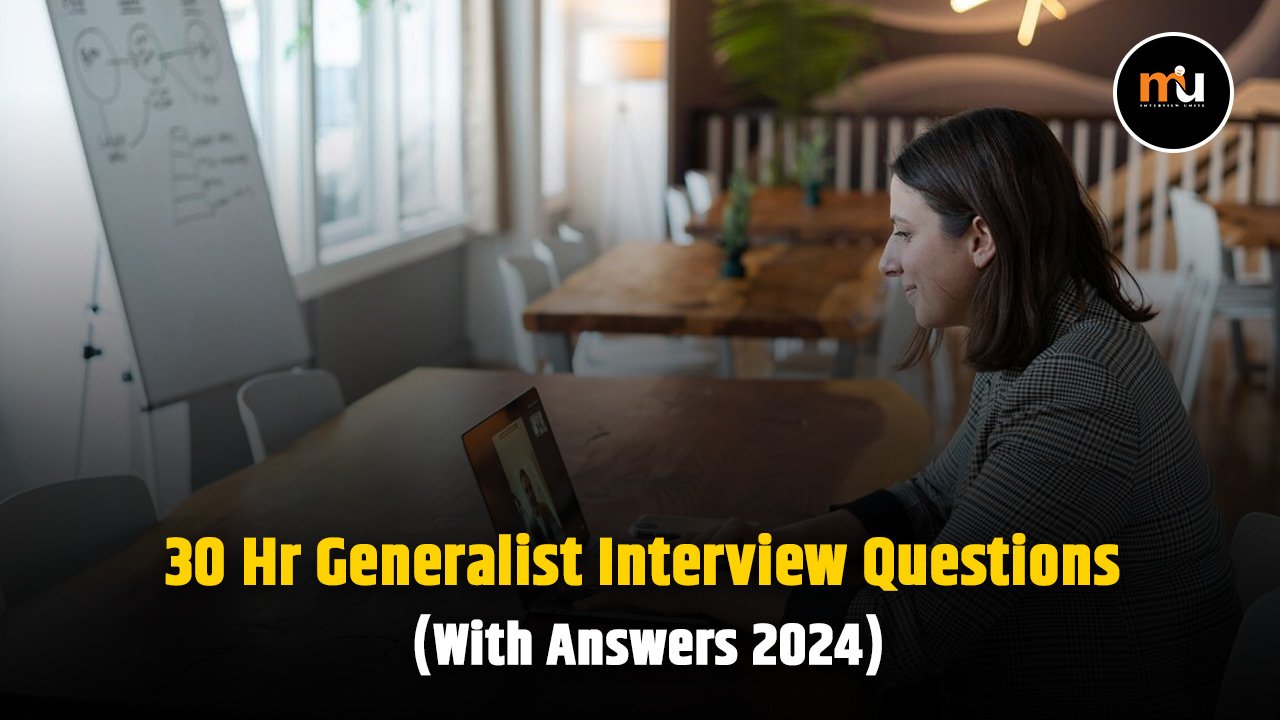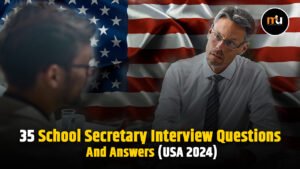Being a generalist in HR Generalist Interview demands the ability to show versatility across the spectrum of recruitment, employee relations as along with compensation and learning initiatives. The preparation for an interview involves planning questions that assess the analytical and strategic thinking skills in addition to technical understanding.
Below is a list of generalist HR interview topics along with examples of answers can help you show off abilities who are eager to help to achieve the goals of your company.
Understanding the kind of questions you will be being asked will enable you to identify relevant experiences and key skills like change control, policies knowledge and analytical abilities, and the ability to collaborate, which allows HR Generalist to make an impacts and meet the requirements of all employees in the organization.
30 Hr Generalist Interview Questions And Answers
1. Why Are You Interested In This HR Generalist Role?
Example Answer: As a generalist in HR, I’d draw upon my experience in recruiting, along with the all rewards, as well as employment and relationships, to provide a valuable guidance throughout the lifecycle of employees.
This position is attractive to me because I enjoy having a variety of hats on and want to expand my abilities across HR’s various duties.
2. What Do You Think Makes A Successful HR Generalist?
Example Answer: A strong generalist in HR Generalist is a person who is able to apply business knowledge as well as influence as well as the capacity to work out conflicts.
They blend the strategic approach with empathy, meaning they can comprehend the goals of the organization and the employee’s perspectives. They are able to enhance various aspects.
3. What HR Technology Systems Are You Familiar With?
Example Answer: I have extensive experience with applications tracking software for HR information platforms and systems to monitor performance like Namely, Workday, Bamboo HR, Gusto, Oracle HCM and SAP SuccessFactors, ADP, Zenefits and a host of others. I am a quick learner in the field of implementing new technologies.
4. How Do You Stay Current On Employment Laws And HR Best Practices?
Example Answer: Staying up to date with trends and best practices is vital for HR professionals. I stay up-to-date with the latest industry publications, and attend regular continuing education classes throughout the year. I also attend HR conferences frequently as I can.
I also make use of my social media and network to talk about the latest laws that affect areas such as pay equity and data privacy.
5. How Would You Handle An Employee Who Contests A Policy?
Example Answer: First, I’d be open to discussions with them about the issues and the limitations they have to confront.
If I were you, I’d look at alternative options that are mutually beneficial, and which align to the policy’s intentions. If the options aren’t satisfactory, I’d then outline the reasons behind why they are not suitable so that employees understand that the policy was designed to benefit employees and the company.
6. What Is Your Process For Investigating Harassment Complaints?
Example Answer: Once I am informed of the any harassment allegations I will promptly meet with the parties involved in an informal manner and record the discussion.
If leadership is consulted regarding the next actions after an analysis of the results, I’d do additional interviews to determine the appropriate response for discipline, like disciplinary measures and training sessions, or policy changes that will ensure confidence and protect the integrity for our values.
7. Tell Me About A Time You Struggled To Fill An Open Position. What Was The Outcome?
Example Answer: Ample Solution searching director of marketing posts we were faced with less qualified applicants initially, despite our vast reach.
I analyzed the location and method in which we placed the ad, suggested increasing the competitiveness of compensation and increased the number of networks on which we were targeted. This resulted in more interest, and we were able to enroll one of the top candidates with the new recruitment strategy within just two months.
8. How Would You Promote Diversity, Equity And Inclusion In Hiring?
Example Answer: To avoid biases and to increase diversity in candidates, I would suggest the standardization of an inclusive skills-based set for job descriptions. Eliminating the non-essential requirements opens up opportunities for all backgrounds.
I also suggest connections to professional groups of minorities, as well as educational institutions as possible sources of candidates as well as incorporating diversity-related indicators in the assessments of recruiters.
9. How Do You Determine Compensation Benchmarking For Roles?
Example Answer: When evaluating the role of compensation I gather broad market wage rates from peer companies and studies of industries.
Then I review factors like what size the business and its location, the amount of experience required within the business, as well as information on the company’s sales and performance indicators to determine the percentages that are targeted to be in line with the capacity of paying in a fair way. This will help keep in balance internal and external equity.
10. What Considerations Go Into Yearly Bonus Determination?
Example Answer: The key inputs in determining annual award selections come from the organization’s budgets, departmental finances as well as the accomplishment of goals that are quantifiable and other indicators that show exceptional contributions, which are only visible at the point of execution.
I integrate these elements and work with the participants from various units to create incentives that support the strategic objectives.
11. What Is The Difference Between Culture And Values? How Do They Interplay?
Example Answer: While company culture mirrors acceptable norms of behavior as well as an overall “feel,” company values influence the leadership philosophy and the priorities teams must adhere to every day.
Positive values are the basis of a positive environment. I encourage openness in conversations and help make sure that messages are translated into the kind of behavior that employees are able to relate to and emulate within the context of a positive culture and behavior.
Related More: 15 Interview Questions For The Nurse Manager (With Answers)
12. Tell Me About A Time You Resolved A Sensitive Employee Relations Situation.
Example Answer: When I received a complaint from an employee that was a concern for the management team I followed the standard procedure for responding without prejudice. To keep as private as I could I conducted myself in a manner that was neutral with all parties, with a an eye on solving conflicts.
The situation was quickly de-escalated after everyone expressed their concerns positively, which enabled day-to-day co-operation to be normalized.
13. What Steps Would You Take If An Employee Reports Feeling Harassed?
Example Answer: If an employee complains of an act of harassment, I’ll take action in accordance with the policy and then conduct the investigation in a confidential manner.
After analyzing the results, I will consult with legal counsel and leaders regarding the best course of course of action based on the severity and frequency including disciplining methods such as coaching, or even training sessions that emphasize zero tolerance.
Making sure that resolutions are in line with the law will prevent an escalate while ensuring that employees are heard and are safe.
14. How Often Should Employee Satisfaction Be Measured?
Example Answer: Annual surveys should be augmented by regular focused groups or pulse surveys to detect issues in advance. Each every month “temperature checks” better assess the requirements of my team, in order to address problems in real-time before engagement levels drop or the result of shifts in staff.
If a number of data points show declines, I look into the causes by introducing data collection channels which permit adaptive improvements.
15. What Methods Exist For Determining Employee Turnover Drivers? How Would You Address Them?
Example Answer: Exit interviews, surveys of engagement and feedback from managers and HR analytics can influence my perception of root causes. I’d prefer to address problems by boosting morale as well as open and honest communication.
Implementing buddy programs to aid to integrate and grow also aids to improve retention because employees will feel valued and engaged in.
16. How Can HR Impact Business Strategy?
Example Answer: HR in Example is a crucial part of a business’s strategy through initiatives to plan for the workforce and management changes following the introduction of new systems in place, and programs to develop talents that align the abilities of employees with the company’s strategic objectives.
The development of crucial internal capabilities is what builds the pipelines of innovation required to execute changing strategy each year.
17. How Can You Demonstrate The Value Of The HR Function?
Example Answer: Metrics showing cost of labor reductions, better recruitment funnels, reduced turnover and better engagement tracks show the importance for HR, ROI and other aspects.
I also think about the ROI on training via efficiency increases or the increase in revenue resulting from the use of new techniques. The emphasis on HR contributions to strategic initiatives will reassure all stakeholders regarding HR’s role in increasing the efficiency of their work.
18. What Kinds Of HR Metrics Would You Track And Report To Leadership?
Example Answer: of HR metrics I’d be monitoring include time-to-fill rate, scores of satisfaction of hiring managers as well as the diversity of representations of engagement surveys as well as the cost of training versus the growth in bench strength
The distribution of performance ratings, turnover and retention statistics are classified by tenure as well as the reason for hiring, in addition to cost per employee. Sorting the data by he departmental and demographic variables helps in identifying the areas that need attention.
19. Tell Me About A Time You Had To Discipline Or Terminate An Employee.
Example Answer: When performance issues surfaced in a team member despite first efforts by coaching, I adhered to the established methods of managing performance with a clear mind and also demonstrated compassion during our discussions.
First, it was important to create the possibility of improvement. It was crucial prior to deciding to divide on the basis of objectives that weren’t met during the course of time. The procedure of setting ethical standards eased the transitions.
20. What Is Your Experience With Labor Relations And Unions?
Example Answer: Although I haven’t directly engaged in bargaining for through the process of collective bargaining, i have respect for the process as well as both sides’ interests if they are utilized effectively.
I have assisted in interpreting contracts as well as assisted in facilitating communication between union and management representatives. My previous position also included me participating in mediations with labor for creating an understanding.
21. How Can You Create An Ethical Culture As An HR Professional?
Example Answer: I demonstrate integrity through fair recruitment, compensation and promotion uniformity, and policy consistency to avoid conflicts of interest and to protect confidentiality.
The integration of ethics in the core of education and applauding the values that are demonstrated every day builds a positive culture. Making sure that everyone is accountable at all levels can help to avoid from being viewed as unfair advantages that can undermine ethical standards.
22. How Would You Approach An HR Project That Requires Cross-Functional Collaboration?
Example Answer: Cross-functional projects require clear charters that are clearly defined with all leaders collaborating on norms as well as systems and processes in the beginning, while focusing on interlocking deliverables, handoffs and common metrics that drive success.
Transparency regarding blockers is vital and frequent checks-ins guarantee that milestones are reached seamlessly.
23. Tell Me About A Time You Convinced Others To Support An HR Initiative Or Significant Change. How Did You Get Buy-In?
Example Answer: Rolling out a brand new HR Generalist Interview is platform required acceptance in 19 locations. This was difficult because change fatigue was a factor. To promote adoption, I worked with the key influencers to develop content that addressed the concerns.
In some ways, I was able to understand the resistance to change, and thus offered massive assistance to smooth transitions within my plan. The leadership was supportive of the plan following the time presented, with the efficiency of the plan and cultural sensitivity balanced.
24. Describe A Time You Had To Push Past Barriers. What Was The Result?
Example Answer: The benchmarking of compensation revealed gaps in particular roles and levels, the management initially was hesitant to address the issue because of budgetary constraints. I came up with a multi-year strategy to enhance the stages based on the duration and the results.
My ongoing efforts to inform employees about the higher costs associated with turnover has earned me the approval by the executive committee for Phase One, which allows us to show the positive effects of retention prior to the next budget debates.
25. What Existing HR Policy Would You Change? Why And How?
Example Answer: I would increase paternity leave for fathers who have just become new and second-caregivers who are more in line with the best practices of peers at work. Promoting fair parenting and bonding early can improve children’s health as well as longer-term outcomes at a low expense in comparison to.
My intention is to demonstrate benchmarking and to highlight the expected benefits that research has proven to be the potential for parental involvement to boost efficiency.
26. If We Could Not Fulfill One Area Of HR For The Next Year, What Should That Be And Why?
Example Answer: If I had to end an HR function because of restrictions external to the organization the issue would be budgets for training and development. Though continuous learning is crucial, formal mentoring programs, as and the opportunities for job shadowing within your company are tiny, and they are not promoting expansion.
In the face of a shortage of resources the goal of maximizing the transfer of knowledge from the existing experts should be given precedence over bringing new leaders to the outside. Internal mobility also helps keep employees.
27. Have You Ever Made A Significant Mistake? How Did You Handle It?
Example Answer: In the beginning of my career, I was inclined to speed through background checks needed to gain a position as a leader, but I didn’t have enough background checking expertise.
Luckily, the risks were discovered before negative consequences occurred and I was able to gain essential lessons on due diligence and ensuring that there are no false assumptions being made, and properly scaling. I’m currently three-checking the credibility of the process by employing an improvement mindset.
28. How Would Colleagues Describe Your Work Style?
Example Answer: My colleagues often describe my style of work as thorough, yet flexible when needed. I maintain my focus on specifics while allowing myself to adjust to shifting priorities and deadlines.
Building positive relationships with my team helps me deliver consistently the best service in a time of stress particularly when my colleagues aid me in navigating the pitfalls.
29. Why Do You Want To Leave Your Current Job?
Example Answer: I’ve enjoyed my knowledge and experience at my current position. However, I am searching for opportunities to gain more impactful involvement and to make the most of my capabilities.
The chance to manage programs in a holistic manner is a great way to offer innovative and insightful solutions to improve employee satisfaction and performance of the organization.
30. Do You Have Any Questions For Me About This Opportunity Or The Team?
Example Answer: This opening is compatible with the creative and collaborative culture that I am a fan of. Who should I collaborate with on strategic initiatives?
Are there areas of growth that the candidate chosen can be expected to be a part of? I would like to know any details that you have on how my experience ties in with the current goals or projects being in the pipeline for the future.
HR Generalist Interview Some Tips
Do your research to know their goals as well as their values, structure, as well as any current news or issues they face. This can help you answer any questions about the reasons you’d like to work at the company specifically.
Examine the most frequently asked HR questions, and create stories from your own experiences that show the skills required for changes management, employee relations compliance, training, etc. Prepare to discuss specific instances.
Get acquainted with current trends and happenings in HR, such as the remote working policies DEI programs, the use of people data and more. Think about how you can improve or implement these areas.
Create questions you can be asked at the end of the meeting concerning things like common career pathways, the challenges for the position, work environment, etc. This shows that you are interested.
Reread the job description and prepare yourself to explain about how your abilities and experience match exactly the requirements of the job. Utilize some of the most important terms from JD in your answers.
Give clear examples of when you dealt with issues with employee relations, recruited qualified candidates, designed training programs, streamlined compliance, etc. Make sure you quantify your achievements when possible.
Try to speak concisely, but clearly about your experiences. Practice talking about yourself professionally.
Dress professionally and be courteous to all people you meet A hiring manager may be looking for their opinions of your appearance and manner of conduct.
Final Thought
The preparation for a HR Generalist interview involves time, research, practice as well as understanding one’s own capabilities and achievements.
Through reviewing the most frequently asked questions regarding how to resolve workplace conflicts, recruitment compliance, training and showing strategic thinking Candidates can communicate their strengths through compelling examples.
Furthermore, understanding the role and expectations of the company helps one make sure that their experiences are aligned with important objectives. With a little preparation and confidence, potential HR generalists can handle this hiring process.
Disclaimer: The article offers general advice and examples. you must research each individual company and position to customize and practice responses. Successfully completing interviews requires a lot of effort and a personal approach each time.






